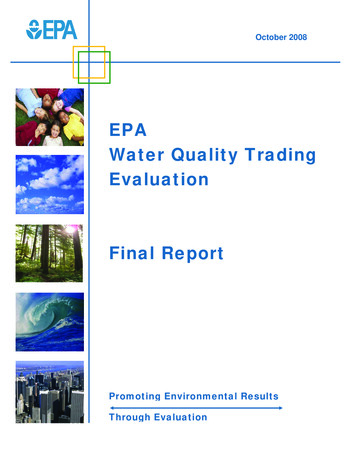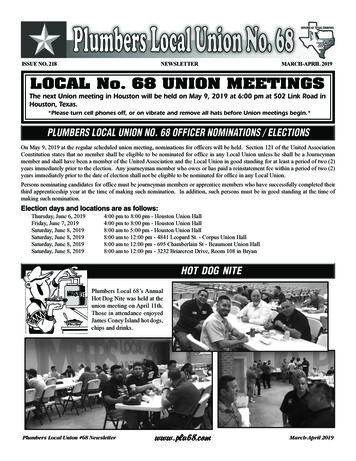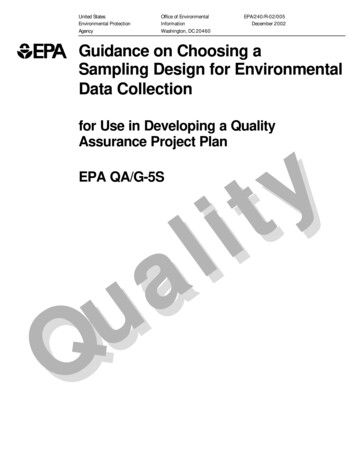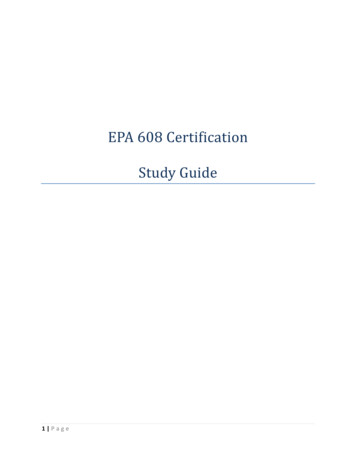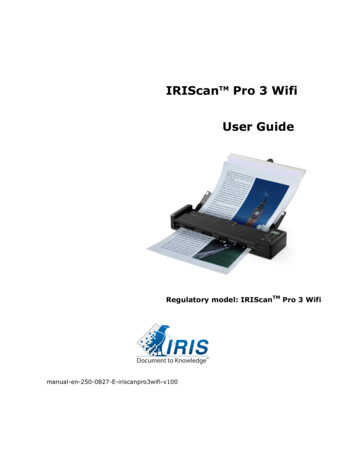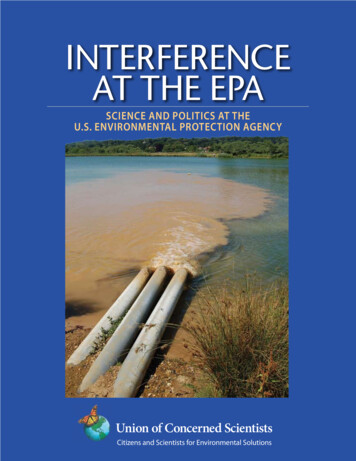
Transcription
Interferenceat the EPAScience and Politics at theU.S. Environmental Protection AgencyUnion of Concerned ScientistsCitizens and Scientists for Environmental Solutions
Interferenceat the EPAScience and Politics at theU.S. Environmental Protection AgencyThe Scientific Integrity Program of theUnion of Concerned ScientistsApril 2008
iiUnion of concerned scientists 2008 Union of Concerned ScientistsThe Union of Concerned Scientists is the leadingscience-based nonprofit working for a healthyenvironment and a safer world.The UCS Scientific Integrity Program mobilizes scientistsand citizens alike to defend science from political interferenceand restore scientific integrity to policy making. Moreinformation about UCS and the Scientific Integrity Programis available online at www.ucsusa.org/scientific integrity.The full text of this report is available on the UCS website(www.ucsusa.org/publications) or may be obtained from:UCS Publications2 Brattle SquareCambridge, MA 02238-9105Or, email pubs@ucsusa.org or call (617) 547-5552.D e si g n :David Gerratt/NonprofitDesign.com iStockphotoC o v e r p h otos :
I n t e r f e r e n c e at t h e e paContentsFigures, Tables, and BoxesvContributorsviAcknowledgmentsviiExecutive Summary1. Introduction2. History and Organization of the EPA1911History11Key Environmental Laws12The Role of Science in the Policy Process14The Organization of the EPA16Funding Trends193. Research Methods20Creating the Survey Mailing List20Defining “Scientist”21Survey Questionnaire21Survey Demographics21The EPA’s Response22Interviews and Document Requests224. Political Interference in Scientific Work23Survey Results23Case Studies26Discussion365. Barriers to the Free Communication of Science38Survey Results38Case Studies39Discussion43iii
ivUnion of concerned scientists6. Undermining the Role of Science in EPA Decision Making44Survey Results44Case Studies45Discussion497. Challenges to Agency Effectiveness50Survey Results50Case Studies52Discussion548. Recommendations and Conclusions55Protecting EPA Scientists55Making the EPA More Transparent56Reforming the Regulatory Process58Ensuring Robust Scientific Input to EPA Decision Making59Depoliticizing Funding, Monitoring, and Enforcement60Concluding Thoughts60References62Appendices68A. Survey Text and Responses68B. Selected Survey Results75C. EPA Response to UCS Survey Mailing85D. CSSM Methodology Report86Photo CreditsPage 1Page 3Page 4Page 7Page 9Page 11Page 13Page 14Page 23Page 28Page 31Page 33iStockphotoiStockphotoiStockphotoFrancesca Grifo/UCSMark Wilson/Getty ImagesJoe Traver/Getty ImagesFrancesca Grifo/UCSiStockphotoiStockphotoiStockphotoSara McDonald/SXCU.S. EnvironmentalProtection AgencyPage 36 Gerardo Blumenkrantz/UCSPage 37 Michael Siluk/PhotolibraryPage 38 iStockphotoPage 40 iStockphotoPage 42 iStockphotoPage 44 Corbis ImagesPage 47 Center for LandUse Interpretationphoto archivePage 49 Jupiter ImagesPage 50 American Federation ofGovernment EmployeesCouncil of EPA Local #238Page 53 Hilton Kelley/CIDA Inc.Page 55 iStockphotoPage 56 IndexOpenPage 59 Jupiter ImagesPage 60 Reva Sharp/UCSPage 61 Digital Vision
I n t e r f e r e n c e at t h e e paFigures, Tables, and BoxesFigures1. The EPA’s Risk Assessment and Risk Management Paradigm152a. The EPA’s 12 Central Offices and 10 Regional Offices162b. The National Laboratories and Centers of the EPA’sOffice of Research and Development173. Map of the EPA’s 10 Regions and 16 Laboratories and Facilities184. EPA Budget 1999–2009195. Basic Demographics of Survey Respondents226. Number of EPA Scientists Reporting Various Formsof Political Interference247. Political Interference across the EPA over the Past Five Years268. Direct and Indirect Interference at EPA Offices and Labs279. Scientists’ Perceptions of the EPA’s Communications Policies3910. Decreased Job Satisfaction and Political Interference51Tables1. Summary of the Survey’s Sample Size and Response Rate21Boxes1. The OMB Overrules EPA Science282. More Examples of Political Interference in EPA Science35
viUnion of concerned scientistsContributorsTimothy Donaghy is an analyst with the UCS Scientific Integrity Program.He holds a Ph.D. in physics from the University of Chicago.Francesca Grifo is the senior scientist and director of the UCS ScientificIntegrity Program. She holds a Ph.D. in botany from Cornell University.Meredith McCarthy is a research assistant with the UCS Scientific IntegrityProgram. She holds an M.S. in astronomy from the University of Maryland–College Park.
I n t e r f e r e n c e at t h e e paAcknowledgmentsThis report was made possible in part by the generous financial support of the Beldon Fund,the Gunther Family, The William and Flora Hewlett Foundation, The Stephen and TabithaKing Foundation, Open Society Institute, The David and Lucile Packard Foundation, TheStreisand Foundation, and the Mendel McCormack Fund of the Tides Foundation.This report would not have been possible without the input of dozens of former and currentEPA employees who shared their experiences, their stories, and their time. We would alsoespecially like to thank those EPA employees who took the time to complete the survey.The authors would like to thank:Jan Larson, Allison Tyler, Sarah Nusser, Cherie Alf, Rick Charles, Jean Opsomer, DianneAnderson, Karen Fliehler, Glenda Ashley, Russell Hoffman, and the other staff of the Centerfor Survey Statistics & Methodology at Iowa State University for their advice, expertise,and invaluable assistance in implementing the survey and analyzing the results.Jennifer Freeman for her skillful Internet sleuthing and Seth Shulman for his investigativeacumen; Karly Kaufman and Celia Wexler for their insight into legislative solutions, EmilyNeaville for the report’s photos and captions, and Rebeca Bell, Krystina Lafontant, andPatrick Baur for entering the mailing list data and analyzing respondents’ essays.Bill Hirzy, Bruce Buckheit, Sean Moulton, Janice Nolan, Deborah Shprentz, Jennifer Sass,Kirsten Stade, Cindy Pellegrini, Doug Gurian-Sherman, Michelle Robinson, and severalunnamed EPA scientists for their wisdom and valuable conversations.David Michaels, Mike Walsh, Eric Schaeffer, Mollie Churchill, Rick Melberth, MichaelHalpern, Kathy Rest, Kurt Gottfried, and an unnamed former EPA scientist for providingvaluable comments on an early draft of this report.Sandra Hackman for her masterful editing, David Gerratt for his deft layout and design,Heather Tuttle for her production assistance, and Bryan Wadsworth for his patience anddiligence in keeping us on track.Our families for their love and support.The opinions expressed in this report do not necessarily reflect those of the foundationsthat supported this work, or of the individuals who reviewed and commented on it. Both theopinions and the information contained herein are the sole responsibility of the authors.vii
I n t e r f e r e n c e at t h e e paExecutive SummaryThe U.S. Environmental ProtectionAgency (EPA) has the simple yetprofound charge “to protect humanhealth and the environment.” EPAscientists apply their expertise to protect thepublic from air and water pollution, clean uphazardous waste, and study emerging threatssuch as global warming. Because each yearbrings new and potentially toxic chemicalsinto our homes and workplaces, because airpollution still threatens our public health, andbecause environmental challenges are becoming more complex and global, a strong andcapable EPA is more important than ever.Yet challenges from industry lobbyists and somepolitical leaders to the agency’s decisions havetoo often led to the suppression and distortionof the scientific findings underlying those decisions—to the detriment of both science and thehealth of our nation. While every regulatoryagency must balance scientific findings withother considerations, policy makers need accessto the highest-quality scientific information tomake fully informed decisions.Concern over this problem led the Union of Concerned Scientists (UCS) to investigate politicalinterference in science at the EPA. In the summer of 2007, UCS, working with the Center forSurvey Statistics and Methodology at Iowa StateUniversity, distributed a 44-question survey tonearly 5,500 EPA scientists, asking for informationabout political interference in their scientific
Union of concerned scientistswork, the use of science in EPA decision making,barriers to communication, employee morale,and the agency’s effectiveness. UCS identifiedthese scientists through EPA websites, consultations with current and former employees, andtargeted Internet searches.There are still good scientists producinggood science at USEPA. The main problemI see is an administration that considersscience only if it supports its agenda. Asin other areas, science is used only if itfurthers preexisting policy; otherwise itis ignored, marginalized or suppressed(e.g. climate change).A scientist from the EPA regional officesWe received completed surveys from 1,586scientists, for a response rate of 29 percent.These respondents represented every scientificprogram office at EPA headquarters, all 10 regional offices, and more than a dozen researchlaboratories across the country. Most respondents were agency veterans, with more than adecade of experience at the EPA. Beyond specific survey questions, more than 850 scientistsalso provided written comments in responseto an open-ended essay question. To add tothis information, UCS interviewed dozens ofcurrent and former EPA scientists.The results of these investigations show anagency under siege from political pressures.On numerous issues—ranging from mercurypollution to groundwater contamination toclimate change—political appointees of theGeorge W. Bush administration have editedscientific documents, manipulated scientificassessments, and generally sought to undermine the science behind dozens of EPAregulations.* Unless otherwise stated, percentages reflect the shareof respondents who answered a specific question.These findings highlight the need for strongreforms to protect EPA scientists, make agencydecision making more transparent, and reducepoliticization of the regulatory process.Political Interference in Scientific WorkLarge numbers of EPA scientists reported widespread and inappropriate interference by EPApolitical appointees, the White House, andother federal agencies in their scientific work: 889 scientists (60 percent of respondents*)personally experienced at least one incidentof political interference during the pastfive years. Among EPA veterans (scientists with morethan 10 years of experience at the agency),409 (43 percent) said interference occurredmore often in the past five years than inthe previous five-year period.EPA scientists also reported personally experiencingspecific forms of political interference, from theexplicit to the subtle: 94 scientists (7 percent) had frequently oroccasionally been “directed to inappropriatelyexclude or alter technical information froman EPA scientific document.” 191 scientists (16 percent) had personally experienced frequent or occasional“situations in which scientists have activelyobjected to, resigned from, or removedthemselves from a project because ofpressure to change scientific findings.” 232 scientists (18 percent) had personallyexperienced frequent or occasional “changesor edits during review that change themeaning of scientific findings.” 285 scientists (22 percent) had personallyexperienced frequent or occasional “selectiveor incomplete use of data to justify a specificregulatory outcome.”
I n t e r f e r e n c e at t h e e pa 153 scientists (13 percent) had personallyexperienced frequent or occasional “pressureto ignore impacts of a regulation on sensitivepopulations.” 299 scientists (24 percent) had personallyexperienced frequent or occasional “disappearance or unusual delay in the release ofwebsites, press releases, reports, or otherscience-based materials.” 394 scientists (31 percent) had personallyexperienced frequent or occasional “statements by EPA officials that misrepresentscientists’ findings.”Respondents indicated that political interferencearose from both internal and external sources: 516 scientists (43 percent) knew of “many orsome” cases where EPA political appointeeshad inappropriately involved themselves inscientific decisions. 560 scientists (49 percent) knew of “manyor some” cases where political appointees atother federal agencies had inappropriatelyinvolved themselves in decisions. 507 scientists (42 percent) knew of “manyor some” cases where “commercial interestshave inappropriately induced the reversal orwithdrawal of EPA scientific conclusions ordecisions through political intervention.” 329 scientists (28 percent) knew of suchinterference by “nongovernmental oradvocacy groups.”In essay responses, nearly 100 scientists identified the White House Office of Managementand Budget (OMB), which oversees the federalbudget and coordinates all federal regulations,as the primary source of external interference.A landfill near the WasatchMountains in Utah.Respondents reported widespread respect for theirdirect supervisors, but had fewer commendationsfor the EPA’s senior leaders: 1,282 scientists (81 percent) respected theintegrity and professionalism of their directmanager or supervisor, while 686 (43 percent) said the same about the EPA’s seniorleaders. A majority of respondents (906 scientists,or 59 percent) agreed that their direct supervisor stands behind scientific staff whoexpress politically controversial opinions.
Union of concerned scientistsRates of political interference varied widelyamong offices and divisions within the agency: The percentage of scientists reporting interference was highest in the program officeswith regulatory duties, and at EPA headquarters. A total of 337 scientists in the programoffices (68 percent), and 379 scientists atheadquarters (69 percent), reported at leastone incident of interference in the pastfive years. The percentage of scientists reporting interference was lower—although still significant—in the Office of Research and Development(ORD), the EPA’s main research arm. The ORD’sNational Health and Environmental EffectsResearch Laboratory was notably freer ofinterference (39 percent) than any other EPAdivision, while its National Center for Environmental Assessment had the highest percentage of scientists reporting interferenceof all EPA divisions (84 percent). The percentages of scientists reportinginterference in the 10 regional offices variedwidely, from 44 percent (region 6) to 73percent (region 9).To place these results in context, we cite specificincidents of interference. For example, politicalappointees at the White House and in top positions at the EPA manipulated scientific findingsand analyses regarding mercury pollution andclimate change. These incidents involved pressure to change scientific methods and findings,direct editing of scientific documents by nonscientists, and delayed release of scientificreports.A third case—involving interagency reviewof the EPA’s assessment of toxic chemicals—illustrates the growing ability of the OMB andother federal agencies to review and secondguess the work of the EPA’s scientific experts.
I n t e r f e r e n c e at t h e e paBarriers to the Free Communicationof ScienceThe free communication of scientific resultsis a critical part of the scientific process.Despite statements by EPA leaders asserting thatthe agency supports scientific openness, manyscientists report that it restricts free communication of the results of taxpayer-funded research: 783 scientists (51 percent) disagreed orstrongly disagreed that EPA policies allowscientists to “speak freely to the news mediaabout their findings.” Another 556 scientists(36 percent) had no opinion or were unsure.Only 197 scientists (13 percent) agreed thatthe EPA allows scientists to communicatefreely with the media. 291 scientists (24 percent) disagreed orstrongly disagreed that they are “allowedto publish work in peer-reviewed scientificjournals regardless of whether it adheresto agency policies or positions.”Beyond these restrictive policies, hundreds ofscientists said they fear retaliation for speakingcandidly about the EPA’s work. More scientistsfeared retaliation for speaking candidly insidethe agency than outside it: 492 scientists (31 percent) disagreed orstrongly disagreed that they could openlyexpress concerns about the EPA’s work insidethe agency without fear of retaliation. 382 scientists (24 percent) disagreed orstrongly disagreed that they could openlyexpress concerns about the EPA’s work outsidethe agency without fear of retaliation.Interviews with current and former EPA scientists revealed new examples of problems incommunicating scientific research. In two cases,EPA scientists were barred from presenting research on climate change at scientific conferences.Other scientists reported difficulties speakingwith the media and obtaining EPA clearanceto publish their findings in scientific journals.Political interference in scientific work combined with barriers to the free communicationof scientific findings affect the amount andquality of information the U.S. public receives.EPA needs dynamic, scientific leadership interested in the well being of theenvironment and public health. EPAshould not be the political agency ithas become, the right hand of industryand short economic gain.A scientist from the Office of Solid Wasteand Emergency ResponseUndermining the Role of Sciencein EPA Decision MakingScientific information is the lifeblood of much ofthe EPA’s work and the credibility of its decisionsdepends on the quality of its scientific work.A plurality of EPA scientists reported that theagency’s regulatory policies are consistent with itsscientific findings. However, a similar number feltthat the EPA could do a better job of using thebest judgment of its scientific staff: 745 scientists (48 percent) felt that the EPA’sdeterminations and actions are frequently oralways consistent with the scientific findingsin agency documents and reports. 719 scientists (47 percent) felt that theEPA’s determinations occasionally, seldom,or never make use of the best judgment ofits scientific staff.Hundreds of EPA scientists also felt that the agencyonly occasionally incorporates expert advice fromadvisory committees into policy decisions:
Union of concerned scientists 553 scientists (36 percent) felt that theagency occasionally, seldom, or never heedsadvice from independent scientific advisorycommittees.Recent changes in the EPA’s process for settingthe National Ambient Air Quality Standards provide one prominent example of how politicalconsiderations have trumped scientific expertise and sidelined the EPA’s scientific advisorycommittees.Do not trust the Environmental Protection Agency to protect your environment.Ask questions. Be aware of political andeconomic motives. Become politicallyactive. Elect officials with motives toprotect the environment and holdthem accountable.A scientist from an EPA regional officeChallenges to Agency EffectivenessBeyond political interference in EPA science,several survey questions asked respondentsabout other factors that could impair theirability to do their jobs, and the ability of theagency as a whole to fulfill its mission.regions 5, 6, and 7, which had their librariesclosed (86 of these scientists, or 48 percent,agreed). 574 scientists (41 percent) agreed or stronglyagreed that “the trend toward contractingout scientific work is harming the effectiveness of my division.”Survey questions also asked scientists about theirjob satisfaction, and the morale in their division: Twice as many respondents reported adecrease in job satisfaction over the pastfive years as those who reported an increase(670 versus 328 scientists). Opinions about workforce morale variedwidely. A total of 564 scientists (37 percent)said morale was fair, and 387 (25 percent)said morale was poor or extremely poor.A total of 570 scientists (37 percent) saidmorale was good or excellent.Questions about the overall effectiveness of theEPA elicited a range of responses:Large numbers of EPA scientists indicated thata lack of sufficient or appropriate resources wasa serious issue in their office or division: Respondents were more likely to agree thandisagree that the EPA was acting effectivelyto clean up environmental problems. A totalof 812 scientists (52 percent) agreed that theEPA acts effectively to “clean up and/ormitigate existing pollution or environmentalproblems,” while 522 (33 percent) disagreed. 969 scientists (62 percent) disagreed orstrongly disagreed that the “EPA divisionwhere I work has sufficient resources toadequately perform its mission of protectinghuman health and the environment.” 694 scientists (44 percent) agreed that theEPA acts effectively to “foster practices thatprevent environmental degradation oradverse health effects before they occur,”while 629 scientists (40 percent) disagreed. 555 scientists (36 percent) agreed or stronglyagreed that the “recent changes and closuresin the EPA library system have impairedmy ability to do my job.” This opinion wasespecially prevalent among scientists in Twice as many respondents reported a decrease in the effectiveness of their office ordivision over the past five years (696 scientists, or 45 percent) as those who reportedan increase (321 scientists, or 21 percent).
I n t e r f e r e n c e at t h e e pa Multiple sourcesof air and waterpollution alonga stretch of theHudson River inGlens Falls, NY. Respondents were evenly split on whetherthe EPA is moving in the right direction. Atotal of 685 scientists (44 percent) disagreedthat the EPA is moving in the right direction,while 624 scientists (40 percent) agreed.RecommendationsThe many forms of political interference inEPA science revealed through our survey, ourinterviews, and other sources of informationrequire a suite of solutions in five major arenas:protecting EPA scientists, increasing agencytransparency, reforming its regulatory process,strengthening its scientific advisory system,and depoliticizing funding, monitoring, andenforcement. Protecting EPA Scientists: The agency’sscientists have a profound responsibility to theU.S. public. To fulfill that responsibility, theyneed reassurance that standing behind theirscientific work will not open them to officialor unofficial retaliation. Congress is considering several bills that would strengthen thefederal whistle-blower system. Congressshould pass the strongest possible protections, and the next EPA administrator shouldformally incorporate them into the agency’spolicies. Making the EPA More Transparent: Decisionsmade behind closed doors threaten the integrity of EPA science and the agency’s abilityto protect public health and the environment.Opening up these decisions to congressionaland public scrutiny is an important step inrevealing and ending the misuse of science.The EPA should institute a transparencypolicy for all meetings with representativesof other federal agencies and outside entities. The agency should also create procedures that ensure the periodic release ofscientific documents and prevent them fromremaining in draft form indefinitely. The EPAshould publish a summary statement discussing the scientific basis for each significantregulatory decision, and document dissenting opinions. The agency should also reformits policies to allow scientists to communicate freely with the media, and to quicklyclear their findings for publication in scientific journals, to ensure the free flow ofscientific information. Reforming the Regulatory Process: TheEPA was created to implement and enforcethe nation’s environmental laws, and it hasdeveloped the expertise, experience, processes, and policies needed to fulfill thatcharge. While the White House is responsiblefor overseeing federal agencies, it must strikea better balance between administration priorities and agency independence. The WhiteHouse should respect the agency’s reservoirof scientific and technical knowledge andrestrain the OMB from reviewing the EPA’sscientific and technical documents.
Union of concerned scientistsTo ensure the central role of the environmentin high-level decision making, the next president should elevate the EPA to a cabinet-levelagency. Congress should also consider howto reform and strengthen our nation’s regulatory structure, to meet the pressing environmental challenges of the twenty-first century.notable successes, air and water pollution remainserious public health problems. Each year bringsnew and untested chemicals into our homes,schools, and workplaces. Climate change aloneis projected to have profound impacts on publichealth, agriculture, the economy, and evennational security. Ensuring Robust Scientific Input to theEPA’s Decision Making: The EPA shouldreview and strengthen how it uses thescientific expertise of its staff and externaladvisory committees to create policies—especially when scientific input is critical orrequired by law. Specifically, the next EPAadministrator should work with the Clean AirScience Advisory Committee to improve theprocess for setting the National Ambient AirQuality Standards, to ensure that the administrator relies on the “best available science.”The agency should also tighten its conflictof-interest restrictions.These problems are not insurmountable. Theenvironmental and public health successes ofthe past several decades show that the country can rise to the challenge of environmentalthreats—but only if the EPA has the propertools. Given the complexity of today’s environmental challenges, a credible scientific knowledge base is essential to an effective response.To foster and sustain a healthy scientific enterprise, Congress and the next president shouldtake concrete steps to protect the EPA’s scientists, make the agency more transparent, reformthe regulatory process, strengthen the scientificadvisory system, and depoliticize funding,monitoring, and enforcement. Depoliticizing Funding, Monitoring, andEnforcement: Problems with funding, monitoring and enforcement also need to beaddressed by Congress and the next president to ensure that the EPA is the robust environmental agency that our country needs.Congress should provide the EPA with resources commensurate with its growingresponsibilities and should work to ensurethat selective internal budget cuts are notused to punish inconvenient programs oroffices. The next president should committo strong and consistent enforcement ofthe nation’s environmental laws.Concluding ThoughtsThe EPA’s scientific enterprise is our nation’s firstline of defense against threats to public healthand the environment. These threats are growingmore complex and global, with the potential toharm the nation’s health and prosperity. DespiteScience is not the only element of effectivepolicy making. However, because science enjoyswidespread respect, appointed officials willalways be tempted to manipulate or suppressscientific findings to support predeterminedpolicies. Such manipulation is not only dishonest; it undermines the EPA’s credibility andaffects the health and safety of Americans.The Bush administration’s direct abuse ofscience—combined with systemic changesto the regulatory system that threaten the integrity of EPA science—highlight the need forstrong action by the next president and Congress to restore scientific integrity to the agency’s decision making. Only then can the EPAfully mobilize to serve the public good andensure the nation’s health.
I n t e r f e r e n c e at t h e e pa C hapter 1IntroductionChristine Todd Whitman, a formerRepublican governor of New Jerseywho was George W. Bush’s first administrator of the U.S. Environmental Protection Agency (EPA), resigned her post in thesummer of 2003. In a later interview, sherevealed that her departure came as a directresponse to the White House’s weakening ofEPA regulations on air pollution from agingpower plants. According to Whitman, VicePresident Dick Cheney pushed hard for a rulethat “didn’t hamper industry,” and the final rulewas written “at the direction of the White House,”over the objections of Whitman and EPA staff.Whitman resigned rather than having to publicly defend the new rule, attesting that, “I justcouldn’t sign it. The president has a right to havean administrator who could defend it, and Ijust couldn’t” (Becker and Gellman 2007).EPA decisions have often proved controversial.However, Whitman’s experience illustrates howthoroughly the EPA has become politicized underthe George W. Bush administration, and howtop executive branch officials have overruledthe best advice of the agency’s experts, at timesillegally. Under this administration, political appointees have rewritten scientific documentsabout climate change, pressured EPA scientiststo support pre-determined conclusions aboutmercury pollution, and sidelined the advice ofthe EPA’s independent advisory committees insetting air pollution standards. In these and otherexamples, political appointees used taintedscience to justify weaker protections of publichealth and the environment.In contrast, Russell Train, who served as EPAadministrator under Presidents Nixon and Ford,attested that, “In all my time at the EPA, I don’tHurricaneKatrinadecisionaftermathrecallany regulatorythat was drivenby political considerations. More to the presentChristine Todd Whitman served as EPA administrator under PresidentGeorge W. Bush until her resignation in 2003 over White House interferencein EPA air pollution regulations.point, never once, to my best recollection, dideither the Nixon or Ford White House ever tryto tell me how to make a decision” (Train 2003).Political interference in EPA science threatensthe health and safety of Americans. EPA scientists apply their expertise to protect the publicfrom
94 scientists (7 percent) had frequently or occasionally been "directed to inappropriately exclude or alter technical information from an EPA scientific document." 191 scientists (16 percent) had person- ally experienced frequent or occasional "situations in which scientists have actively objected to, resigned from, or removed

